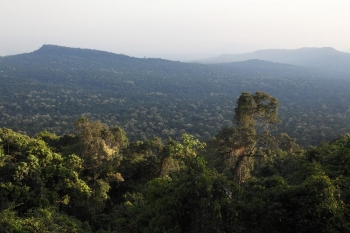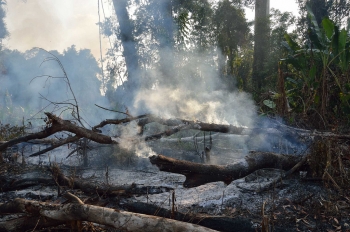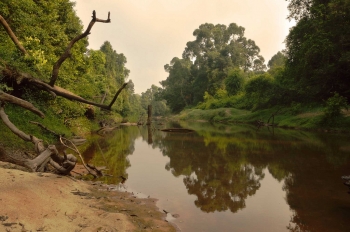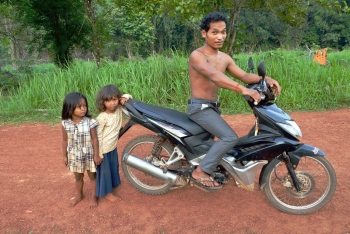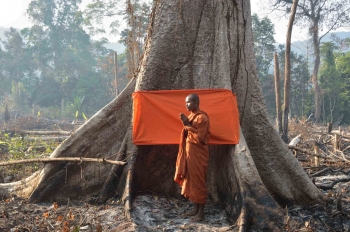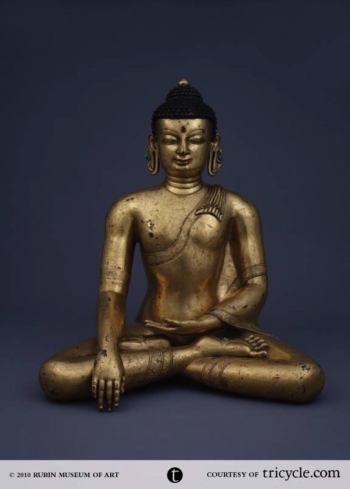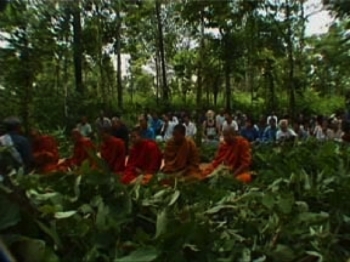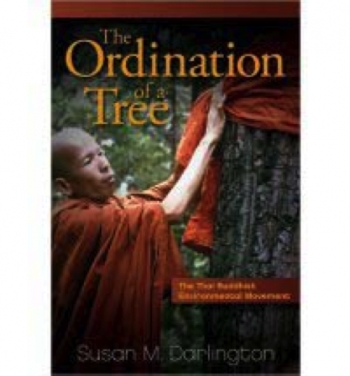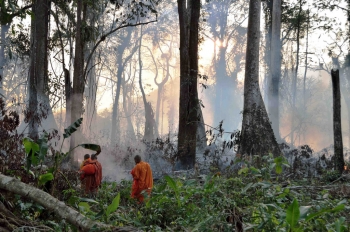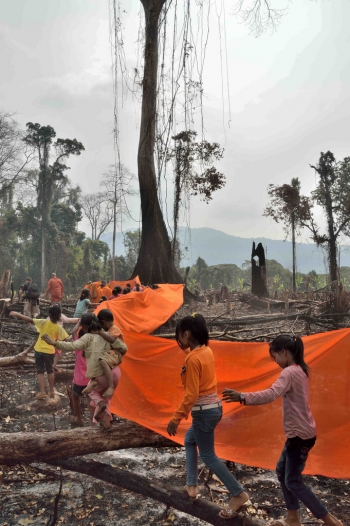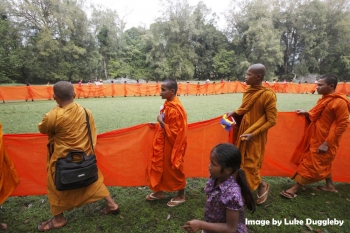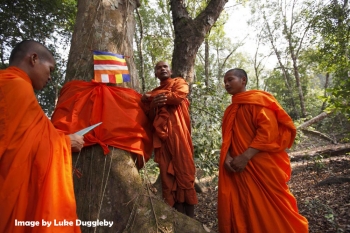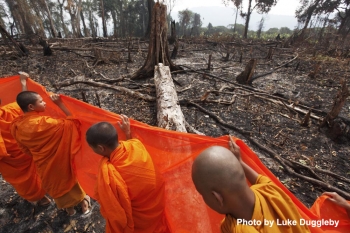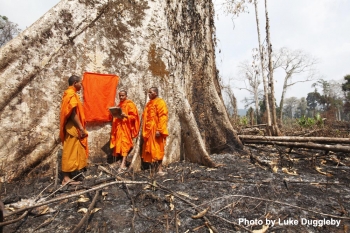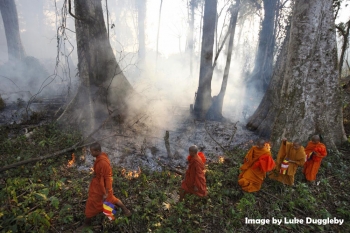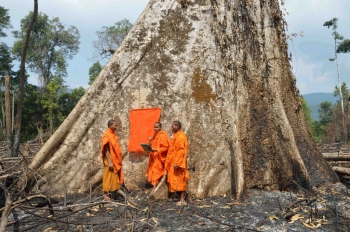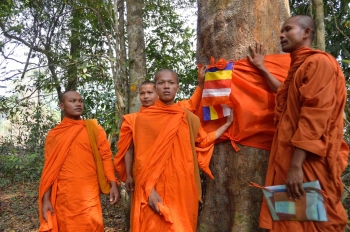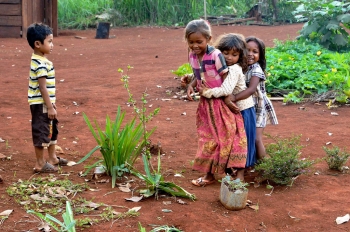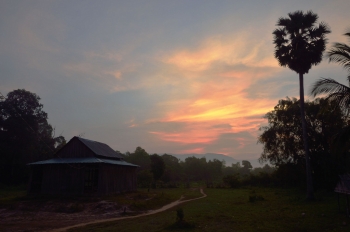Green activist and writer John Seed shares his development of an ecological retreat aimed at helping students get back in touch with the Buddhist principles of nature
Buddha Touched the Earth is the title of a new workshop facilitated by William James, Lisa Siegel and myself. It was first held at North Farm near Bellingen in northern New South Wales, Australia, from February 7 - 10 2012.
Buddha Touched the Earth is the title of a new workshop facilitated by William James, Lisa Siegel and myself. It was first held at North Farm near Bellingen in northern New South Wales, Australia, from February 7 - 10 2012.
The workshop brought together Buddhist meditation with experiential deep ecology processes. Mornings were spent in silence, yoga, sitting and walking meditation. Afternoons and evenings consisted of experiential deep ecology processes as devised by Joanna Macy, myself and others.
The title “Buddha Touched the Earth” refers to the famous story about the Buddha, on the eve of his enlightenment, assailed one last time by Mara who challenged him by asking “By whose authority do you claim this supposed enlightenment?” The Buddha replied by touching the Earth as depicted in countless images and icons and the Earth roared her assent.
I had been involved in Buddhist meditation since my first meditation retreats in 1973 – in Nepal with Lama Zopa and Lama Yeshe and with Goenkaji at Bodh Gaya in India (where the Buddha’s enlightenment took place). Upon returning to Australia, I began to organize meditation retreats around Nimbin in northern New South Wales, first for Phra Khantipalo, a Thai Buddhist monk and then for Christopher Titmuss at the Dhamananda Meditation Centre that we built in the forest. After Christopher’s first retreats in 1976, participants from those events jointly purchased land and began building a community based on Buddhist principles: Bodhi Farm.
The Buddha had an intimate relationship with nature. Prince Siddahartha was born in the Lumbini Sala grove. He attained Buddhahood under a Bodhi (ficus religiosa) tree and on the fifth week after attaining enlightenment the Buddha remained seated under a (Ficus bengalenisis) tree. The seventh week e spent under a tree called Raja-yatena. The Buddha died under a sala tree.
In August 1979, I was part of what is believed to be the world’s first direct action in defense of rainforests which took place at Terania Creek some 8km from Bodhi Farm. Since that time my life has been devoted to the protection of Nature and I have had a recurring interest to bring together these realms of spiritual enlightenment and the conservation of the natural world.
One of my teacher’s, the late Vimala Thakar (1921-2009) saw the film about the Terania Creek actions, “Give Trees a Chance”, and she exclaimed “But this is pure Gandhi! People in India have forgotten how powerful non-violent direct action can be. Please take this film and the story of Terania Creek to India.” Mahatma Gandhi had developed “satyagraha” or “truth force” in his struggles for India’s independence blurring the distinction between political action and spiritual growth.
Through the Gandhi Peace Foundation, Vimala organised a tour and in 1986 Patrick Anderson (Terania activist and Bodhi Farmer who went on to initiate Greenpeace’s first rainforest campaign), my 9-year-old son Bodhi and I travelled by train the length and breadth of India preaching non-violent direct action and rainforests. In Bangalore our gig was organised by Vandana Shiva, in the Himalayas by Sunderlal Bahaguna and the Chipko Movement, in Kerala by Sathis Chandran Nair and in Gujarat by “War Resistors International”.
Not long before her death, Vimala wrote,“In this era, to become a spiritual inquirer without social consciousness is a luxury that we can ill afford, and to be a social activist without a scientific understanding of the inner workings of the mind is the worst folly. Neither approach in isolation has had any significant success. There is no question now that an inquirer will have to make an effort to be socially conscious or that an activist will have to be persuaded of the moral crisis in the human psyche, the significance of being attentive to the inner life. The challenge awaiting us is to go much deeper as human beings, to abandon superficial prejudices and preferences, to expand understanding to a global scale, integrating the totality of living, and to become aware of the wholeness of which we are a manifestation.” (from Moving in Wholeness, 2007)
And it was with these words that I introduced the Buddha Touched the Earth workshop to the participants.
An earlier project to join ecology and spirituality was the Dharma Gaia Trust (DGT) whose mission is to nurture awareness of the complementarity of Buddhism and ecology through, among other things, “generating funds for Buddhist-inspired ecological projects in Asia and the developing world”. Over the years DGT has helped fund ecological projects by Buddhists, especially Buddhist clergy in India, Ladakh, Sri Lanka and Vietnam.
After reviewing suggestions from the DGT Board of Directors as to which program we would fund from the proceeds of this first “Buddha Touched the Earth” workshop, we settled on the Cambodian “Blessing Trees Project” to support Buddhist monks who were preparing to conduct tree ordinations to protect trees and raise consciousness.
One of DGT’s directors, Karma Lekshe Tsomo, Professor of Buddhist Studies at the University of San Diego wrote us about “Buddha Touched the Earth” – “I am not aware of any similar project, at least in the Buddhist world. Thanks for breaking new ground!” We replied that we were inspired by “Stillness in Action” which has been working this ground since the late ‘90’s.
Another initiative which brings together Buddhism and ecology are Yatras. The Sanskrit word ‘yatra’ means ‘journey’, ‘path of life’ or ‘pilgrimage’. Yatras organised by http://yatra.org.au/ are largely silent walks through wilderness areas which offer an opportunity to explore and experience a variety of teachings for personal development in the company of like-minded people while travelling together through the outer as well as inner landscapes of our natural world. Apart from walking through nature, a yatra offers a number of other activities including meditation practice and instructions, yoga and, since 2012, experiential deep ecology processes.
Of course it is of the utmost importance to nourish the growing shoots of ecological concern not only in Buddhism, but in all the world’s spiritual traditions.
My last presentations in North America (sponsored by various churches) were titled “Ecology & Spirituality” and included stories about the overlap of ecology and Christianity, Judaism, Islam, Buddhism and Hinduism. Earth is where all these mighty faiths meet, each has grown from the soil of this planet and it is in the Earth that they are reconciled. One of these stories as depicted in our film “Reweaving Shiva’s Robes” is about a mountain sacred to the Hindu faith.
Arunachala is one of the most sacred sites in India because, in the Hindu tradition, the story is told that their supreme deity, Shiva, manifested as a column of light stretching from infinity to infinity. He was so dazzling that the others gods in the Hindu trinity, Brahma and Vishnu, complained that they were being dazzled beyond endurance.
In his compassion, Shiva took on a new form as this mountain, Arunachala and a vast temple was built at its base. Many believe that walking the 11 km around Arunachala is the fastest way to enlightenment and pilgrims by the millions have thronged there since time immemorial.
In the long line of illustrious sages who have taken up abode in caves on Arunachala was Ramana Maharshi, one of the most celebrated Hindu mystics of the 20th century who died in 1950. In 1987, the Rainforest Information Centre received a letter from one of the nuns in Ramana's ashram telling us that when Ramana had arrived at the mountain as a young man, it had been clothed in a mighty jungle and tigers could be met walking along its flanks. But now, nothing remained but thorns and goats, couldn't we please do something?
We helped the nun set up an NGO and raised funding including two substantial grants from the Australian Government aid agency while volunteers from Australia spent more than seven years helping to reclothe the sacred mountain. After some years, the authorities from the main temple invited us to move our tree nursery inside the temple walls and allowed us the use of their precious waters. Consequently, we initiated the regeneration of the temple gardens, growing flowers for their ceremonies as well as hundreds of thousands of native tree seedlings each year.
When I returned to Arunachala in 2011, I was heartened to find that more than 10 new NGO's had sprung up around the base of the mountain. These inspired groups have constructed native tree nurseries and are engaged in tree planting, environmental education, fire prevention and fire fighting. Not only was I able to walk in the cool shade of the trees our project had planted, but I was able to witness also the regeneration of the ancient association between plants and temples, nature and spirit, God and Earth.
Lisa Siegel: Buddha touched the earth 2500 years ago and the reverberations are still being felt. In the first week of February 2013, thirty curious people gathered for three days at the welcoming and peaceful North Farm in Bellingen, for an exploration of what it means to be alive in this time of immense challenge for our planet. Some of the participants had been following the path of meditation and Dharma study for many years, some had been part of previous Deep Ecology retreats and workshops, but many were new to both deep ecology and Buddhist philosophy. While the majority of participants were from the Mid North Coast, we had participants from as far north as Currumbin Waters Qld, and as far south as Sydney. The age range too was varied – from 22 years old to 69 years young.
One of the participants said afterwards, “Dharma study and deep ecology – it is such an obvious combination!” But not that obvious ... it has apparently not been presented many times before in workshop format. When we thought about why we wanted to combine the two, we came up with three levels of intention. On a personal level: for each individual to explore how the Dharma and deep connection to the planet can be tools for personal sustainability. On a community level: to build connections amongst people who are interested in the study of Engaged Buddhism and in working together towards the healing of the Planet. On a global level: to investigate how the Dharma and deep ecology work can help create the radical shift in consciousness needed in these times of planetary threat. During our three days together, we worked and played together towards these three levels of intention. Much of the workshop was through story telling: Insight Meditation teacher Will James shared the story of “When Buddha Touched the Earth” and spoke to us of dependent arising – how all things “continually change and condition each other in interconnections asreal as the spokes in a wheel” (Joanna Macy). Deep ecologist John Seed helped us walk the billions of years of the story of the Cosmos, and invited us to a “Council of All Beings” in which only the non-humans were allowed to share their stories of concern, and of joy. Facilitator Lisa Siegel shared the story of the vision of a Great Turning that can guide us towards a life-sustaining planet. We all shared personal stories of connection to Mother Earth, and despair at what is happening to her and all her creatures, and delight at her glory. And we all lived the old/new story of the interconnectedness of all things.”
Deep ecology is a term coined by the late Arne Naess, Emeritus professor of Philosophy from Oslo University. Deep ecology looks at the spiritual disease that underlies the environmental crisis: the illusion of separation between humans and the rest of the natural world. According to deep ecology, this illusion stems from anthropocentrism, the sense that human beings are the centre of everything. Naess saw that this anthropocentrism is so deeply embedded in the human psyche that we’re not going to be able to think our way out of the mess that it has created. He claimed that ecological ideas are not enough to save us; what is needed is ecological identity, ecological self. In order to nourish our ecological identity, Naess called for the development of community therapies “which heal our relations with the widest community, that of all living beings.” In 1988 “Thinking Like a Mountain – Towards a Council of All Beings” was published (John Seed, Joanna Macy, Pat Fleming & Arne Naess) launching what is now known as “the work that reconnects” experiential deep ecology processes which move us from ecological ideas to ecological identity.
Two of the processes which I offered at “Buddha Touched the Earth” were The Cosmic Walk and The Council of All Beings itself. In the Cosmic Walk, devised by Sister Miriam Therese McGillis in honour of her mentor the late Thomas Berry, we walked through time. A 50m ball of string represented the 13.7 billion year universe story so each meter we walked represented 274 million years. The wool was laid in a spiral on the floor of the meditation hall and along the spiral were placed 23 tealight candles each representing a story, an emergent property of the Universe. In the centre of the spiral was a candle representing the flaring forth of the Universe, celebrating the stunning fact that anything exists at all. As we chanted Theo Simon’s “Child of the Universe”, the youngest of our party lit a taper from the Big Bang at the centre and walked slowly around the spiral, stopping to light each candle as the unfolding story was told.
In the Council of All Beings, each of us found an “ally” from the non-human world, made a mask to represent that being and then met in council to hear what the more-than-human world had to say.
In honor of the co-incidence that the first Cambodian tree ordination (which was being supported with the $2000 we had raised from workshop fees) was taking place on the same weekend, we planted a Michaelia Chamapaca Alba tree, - White Fragrant Himalayan Champaca – and Gai and Jen who had so graciously and generously donated North Farm and their cooking for our event agreed that we would have it ordained, perhaps the first tree to be ordained in Australia, the next time a suitably qualified Buddhist nun or monk was in the valley.
Will James’ closing remarks: “For me this has been a remarkable weekend and I’d like to thank you all for supporting and creating this magic, the opportunity to explore and inquire into what is really important in life. The title of this weekend was “An Exploration of Engaged Buddhism”. However, I prefer “Engaged Dharma” as “Buddhism” has associations of religion, you’re a Buddhist or you’re not a Buddhist. Dharma is the truth of things, the truth of how nature unfolds naturally and the interconnection of all things. And Dharma is also the teachings that express that and the way of living in harmony with that truth. These are the deep issues that we’ve been exploring. And there is the Buddha Dharma, which is the Buddha’s way of expressing that truth. And there’s the deep ecology Dharma which is another way of expressing that truth. That truth of this deep interconnection and interdependence of all beings. In Dharma language: there is no “other”.
This coming together of Dharma and deep ecology. Actually they are not separate. Both express the deep understanding and deep realization that we can have within our own being. It’s not an intellectual theory, it’s our own experience. It can transform us and transform the way that we relate to each other and to the environment. That has been the core practice that we’ve been exploring. And it is this transformation that is necessary I feel, that’s going to be meaningful and enduring. The action has to come from the open heart, the heart that has been transformed, the heart that sees that deep connection between all beings. That is not self-absorbed. That is open to the world and to each other.
These exercises that we have done over the weekend, seeing into that remarkable story of the evolution of life and to the wonder and the immensity, the unfathomable beauty as well as restoring the inner world, the silence and the stillness from which all this remarkable creation has emerged. I’ve found it an amazing experience and I thank you all for the honor.”
The facilitators have resolved to offer another such workshop in Bellingen August/September and to see whether there is interest in other places.
Arunachala is one of the most sacred sites in India because, in the Hindu tradition, the story is told that their supreme deity, Shiva, manifested as a column of light stretching from infinity to infinity. He was so dazzling that the others gods in the Hindu trinity, Brahma and Vishnu, complained that they were being dazzled beyond endurance.
In his compassion, Shiva took on a new form as this mountain, Arunachala and a vast temple was built at its base. Many believe that walking the 11 km around Arunachala is the fastest way to enlightenment and pilgrims by the millions have thronged there since time immemorial.
In the long line of illustrious sages who have taken up abode in caves on Arunachala was Ramana Maharshi, one of the most celebrated Hindu mystics of the 20th century who died in 1950. In 1987, the Rainforest Information Centre received a letter from one of the nuns in Ramana's ashram telling us that when Ramana had arrived at the mountain as a young man, it had been clothed in a mighty jungle and tigers could be met walking along its flanks. But now, nothing remained but thorns and goats, couldn't we please do something?
We helped the nun set up an NGO and raised funding including two substantial grants from the Australian Government aid agency while volunteers from Australia spent more than seven years helping to reclothe the sacred mountain. After some years, the authorities from the main temple invited us to move our tree nursery inside the temple walls and allowed us the use of their precious waters. Consequently, we initiated the regeneration of the temple gardens, growing flowers for their ceremonies as well as hundreds of thousands of native tree seedlings each year.
When I returned to Arunachala in 2011, I was heartened to find that more than 10 new NGO's had sprung up around the base of the mountain. These inspired groups have constructed native tree nurseries and are engaged in tree planting, environmental education, fire prevention and fire fighting. Not only was I able to walk in the cool shade of the trees our project had planted, but I was able to witness also the regeneration of the ancient association between plants and temples, nature and spirit, God and Earth.
Lisa Siegel: Buddha touched the earth 2500 years ago and the reverberations are still being felt. In the first week of February 2013, thirty curious people gathered for three days at the welcoming and peaceful North Farm in Bellingen, for an exploration of what it means to be alive in this time of immense challenge for our planet. Some of the participants had been following the path of meditation and Dharma study for many years, some had been part of previous Deep Ecology retreats and workshops, but many were new to both deep ecology and Buddhist philosophy. While the majority of participants were from the Mid North Coast, we had participants from as far north as Currumbin Waters Qld, and as far south as Sydney. The age range too was varied – from 22 years old to 69 years young.
One of the participants said afterwards, “Dharma study and deep ecology – it is such an obvious combination!” But not that obvious ... it has apparently not been presented many times before in workshop format. When we thought about why we wanted to combine the two, we came up with three levels of intention. On a personal level: for each individual to explore how the Dharma and deep connection to the planet can be tools for personal sustainability. On a community level: to build connections amongst people who are interested in the study of Engaged Buddhism and in working together towards the healing of the Planet. On a global level: to investigate how the Dharma and deep ecology work can help create the radical shift in consciousness needed in these times of planetary threat. During our three days together, we worked and played together towards these three levels of intention. Much of the workshop was through story telling: Insight Meditation teacher Will James shared the story of “When Buddha Touched the Earth” and spoke to us of dependent arising – how all things “continually change and condition each other in interconnections asreal as the spokes in a wheel” (Joanna Macy). Deep ecologist John Seed helped us walk the billions of years of the story of the Cosmos, and invited us to a “Council of All Beings” in which only the non-humans were allowed to share their stories of concern, and of joy. Facilitator Lisa Siegel shared the story of the vision of a Great Turning that can guide us towards a life-sustaining planet. We all shared personal stories of connection to Mother Earth, and despair at what is happening to her and all her creatures, and delight at her glory. And we all lived the old/new story of the interconnectedness of all things.”
Deep ecology is a term coined by the late Arne Naess, Emeritus professor of Philosophy from Oslo University. Deep ecology looks at the spiritual disease that underlies the environmental crisis: the illusion of separation between humans and the rest of the natural world. According to deep ecology, this illusion stems from anthropocentrism, the sense that human beings are the centre of everything. Naess saw that this anthropocentrism is so deeply embedded in the human psyche that we’re not going to be able to think our way out of the mess that it has created. He claimed that ecological ideas are not enough to save us; what is needed is ecological identity, ecological self. In order to nourish our ecological identity, Naess called for the development of community therapies “which heal our relations with the widest community, that of all living beings.” In 1988 “Thinking Like a Mountain – Towards a Council of All Beings” was published (John Seed, Joanna Macy, Pat Fleming & Arne Naess) launching what is now known as “the work that reconnects” experiential deep ecology processes which move us from ecological ideas to ecological identity.
Two of the processes which I offered at “Buddha Touched the Earth” were The Cosmic Walk and The Council of All Beings itself. In the Cosmic Walk, devised by Sister Miriam Therese McGillis in honour of her mentor the late Thomas Berry, we walked through time. A 50m ball of string represented the 13.7 billion year universe story so each meter we walked represented 274 million years. The wool was laid in a spiral on the floor of the meditation hall and along the spiral were placed 23 tealight candles each representing a story, an emergent property of the Universe. In the centre of the spiral was a candle representing the flaring forth of the Universe, celebrating the stunning fact that anything exists at all. As we chanted Theo Simon’s “Child of the Universe”, the youngest of our party lit a taper from the Big Bang at the centre and walked slowly around the spiral, stopping to light each candle as the unfolding story was told.
In the Council of All Beings, each of us found an “ally” from the non-human world, made a mask to represent that being and then met in council to hear what the more-than-human world had to say.
In honor of the co-incidence that the first Cambodian tree ordination (which was being supported with the $2000 we had raised from workshop fees) was taking place on the same weekend, we planted a Michaelia Chamapaca Alba tree, - White Fragrant Himalayan Champaca – and Gai and Jen who had so graciously and generously donated North Farm and their cooking for our event agreed that we would have it ordained, perhaps the first tree to be ordained in Australia, the next time a suitably qualified Buddhist nun or monk was in the valley.
Will James’ closing remarks: “For me this has been a remarkable weekend and I’d like to thank you all for supporting and creating this magic, the opportunity to explore and inquire into what is really important in life. The title of this weekend was “An Exploration of Engaged Buddhism”. However, I prefer “Engaged Dharma” as “Buddhism” has associations of religion, you’re a Buddhist or you’re not a Buddhist. Dharma is the truth of things, the truth of how nature unfolds naturally and the interconnection of all things. And Dharma is also the teachings that express that and the way of living in harmony with that truth. These are the deep issues that we’ve been exploring. And there is the Buddha Dharma, which is the Buddha’s way of expressing that truth. And there’s the deep ecology Dharma which is another way of expressing that truth. That truth of this deep interconnection and interdependence of all beings. In Dharma language: there is no “other”.
This coming together of Dharma and deep ecology. Actually they are not separate. Both express the deep understanding and deep realization that we can have within our own being. It’s not an intellectual theory, it’s our own experience. It can transform us and transform the way that we relate to each other and to the environment. That has been the core practice that we’ve been exploring. And it is this transformation that is necessary I feel, that’s going to be meaningful and enduring. The action has to come from the open heart, the heart that has been transformed, the heart that sees that deep connection between all beings. That is not self-absorbed. That is open to the world and to each other.
These exercises that we have done over the weekend, seeing into that remarkable story of the evolution of life and to the wonder and the immensity, the unfathomable beauty as well as restoring the inner world, the silence and the stillness from which all this remarkable creation has emerged. I’ve found it an amazing experience and I thank you all for the honor.”
The facilitators have resolved to offer another such workshop in Bellingen August/September and to see whether there is interest in other places.
